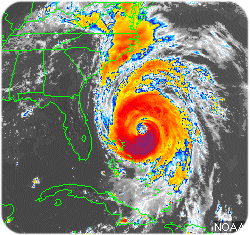![]()

![]()
Partners for Preparedness
Weather the Storms Together
On June 18 - 23, 2000, the American Meteorological Society (AMS) held its 29th Conference on Broadcast Meteorology in San Francisco, California. Federal government presenters included officials from NOAA Headquarters, NOAA's National Weather Service (NWS) and National Environmental Satellite, Data, and Information Service (NESDIS), the National Aeronautics and Space Administration (NASA), and the Federal Emergency Management Agency (FEMA). Linking arms with national broadcast meteorologists, officials from the Geneva-based World Meteorological Organization, and academic scholars from around the country, these Federal and non-Federal partners were gathered for one purpose - - to help prevent loss of life and property due to weather phenomena.
This is Not a Test: NOAA Weather Radios Save Lives
In most severe weather events, lack of warning contributes to fatalities, injuries, and damage that could have been prevented. NOAA Weather Radio is the single source for the most comprehensive weather and emergency information available to the public. It broadcasts the latest information on NWS warnings, watches, forecasts, and other hazards 24-hours a day, as well as post-weather event information for all types of weather hazards. New models even sound alarms to wake sleeping citizens, giving them time to move to shelter and safe ground.
![]()
![]()
![]()

For anyone going out to sea - - storm warnings or not - - an Emergency Position-Indicating Radio Beacon (EPIRB) is a must. It's a device that transmits an emergency signal to search and rescue satellites. NOAA's Geostationary Operational Environmental Satellites (GOES) circle the Earth from pole to pole, instantly detecting these emergency signals and forwarding emergency information first to the NESDIS U.S. Mission Control Center in Suitland, Maryland, then automatically to rescue forces around the world. Today, there are 29 countries participating in the system, and nearly 10,000 lives have been saved worldwide.
NOAA radio technology isn't just aiding residents and seafarers, either. Meteorologists and emergency managers are using state-of-the-art communication technology to connect the Federal agencies responsible for saving lives and property. We've come a long way since Alexander Graham Bell's first telephone and Marconi's first wireless to ensure instantaneous sharing and communication of critical information to those who need it and can use it to reduce casualties and property damage.